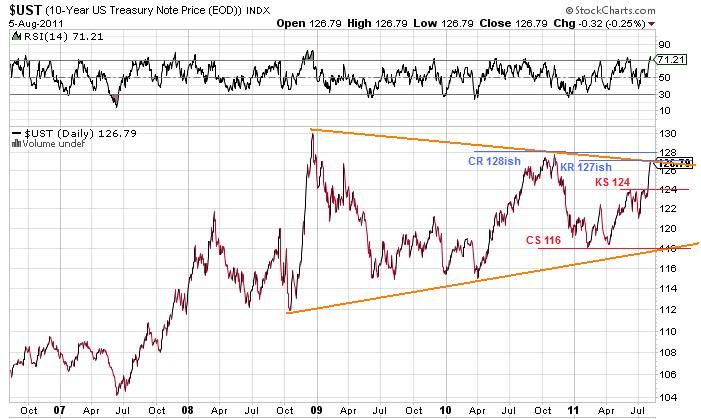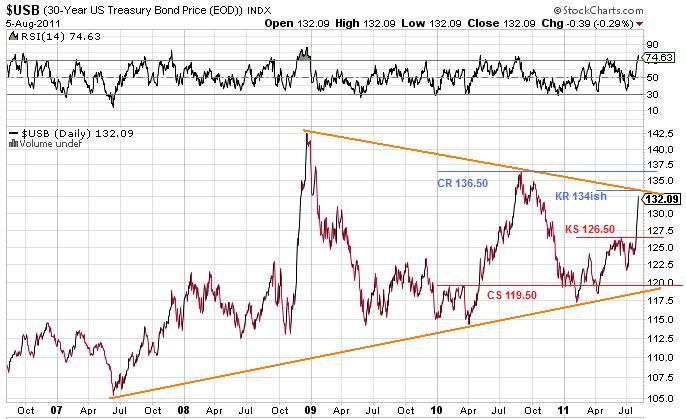The news that has been warned about for years has finally come to reality. The incessant threats made by Moody's and now S&P have now become promise. The USA left the small cadre of countries that hold a AAA rating, knocked down a notch to AA+. They now will be rubbing elbows with Belgium that already has a similar rating. Not so bad, perhaps we will learn how to make really good waffles and Chocolates, clogs are also becoming very fashionable here in the states already.
I'm sure the question that most traders are curious about is: 'what will happen next week?'
My answer is not simple nor complete, for many factors direct market action, however here is a list of factors to consider:
1)Investment firms and insurance companies - Many fixed income investment vehicles and insurance company savings have a policy to keep a significant portion of invested capitol tied to AAA instruments in AAA rated countries. The kind of rock solid, Steady Eddie investments that are usually about as exciting to watch as drying paint, growing grass and bread slices in a toaster. However, with the USA now downgraded below AAA, this will likely cause these firms to formally move out of USA sovereign debt (US treasuries, particularly the 30 year long bond) and give a greater share to those countries that take their budget and debt seriously, like Australia, Austria, Canada, Denmark and other found here: S&P sovereign ratings list
These firms would need to sell their US treasuries, which means moving to cash (USD) for a time before converting to a foreign currency to buy the Bonds of foreign nations. Yep, gonna 'out-source' your nest eggs. In this process buying pressure would be applied to USD for a time as treasuries are converted to cash, followed by selling pressure as that USD converts to foreign currencies in order to buy foreign AAA rated sovereign debt. Many firms have already moved large sums in anticipation, but Friday's downgrade will seal the deal. Unfortunately Gold is not considered a AAA rated investment, so don't expect gobs of money to flow from these institutions into the metal markets. However, those countries that are net exporters of metals and other precious commodities (i.e. Australia, Canada and Norway for example) would likely benefit handsomely. The TC (Transfer and Convertibility) for the USA will still remain AAA, basically suggesting there is no threat of default or market interruption.
2)Sovereign wealth funds, foreign reserve banks - Most of these are likely ahead of the curve, having already diversified away from long term US debt and into commodities and other investments a bit more promising. Whatever portions are left will likely be sold over time and converted. Gold will likely receive a lion's share of the proceeds.
3)Risk-off traders - This could be the fly in the ointment for a time. As you have noticed, US Bonds and metals have been moving up together as a risk-off, safe haven trade away from a volatile stock market. If the 10, 20 and 30 year treasuries fall off sharply come early next week, leveraging on margin would be unwound, followed by margin calls ringing off the hook. Those traders with Gold and Silver holdings will likely be forced to sell their metal positions to cover margin on their losing long side bond bets.
4)The FED - If you look at the trading calendar at the bottom of the blog, you'll notice that August 9th (Tues) is a FOMC meeting. Pressure will be on the FED to 'do something'. If the bond market plummets and yields reverse strongly, the FED may be justified in announcing a federal funds rate increase in an effort to stem a rapidly receding bond market tide. Such a move would be an attempt to shore up the Dollar and thus shore up the US Bond market. Metals would likely have a knee-jerk reaction to the downside, but I suspect only temporarily. However, if the FED Comes out swinging with a hugely unexpected rate increase of over 1%, metals could dive significantly. The FED is in a pickle - Do they continue to ease in order to foster growth and employment, also putting a floor under equities (QE3)? OR do they protect the country's 'credit score'? AT this point, I think the FED has exhausted it's ability to affect change. Trillions in easing, trillions spent.......employment about the same, stock markets still at a lower-high. I imaging that the bulk of any QE3 attempt would march right into tangibles (metals, energy, food).
5)Buy the Rumor, sell the fact - This event has been anticipated for months, it's very possible that the market has already priced it in.
The markets are moving into a chaotic period this month, the clear winners will arrive through the August dust cloud into September onward. I fully expect that Gold will be on top, what ever August flings at it.
Here are a few charts to give some perspective:
The 10 year and 30 year price have come up recently to test major trend-line resistance. Further upside above Key and Critical resistance would suggest a major break-out. However a rejection here and falling through support would likely spark a major slide. The pattern is neutral as consolidation narrows, but a break-out either way is likely to be violent.
The 10 year yield has also fallen to test a multi-year trend-line.
The 30 year yield gives us a workable EW count and bullish iHnS pattern. A fairly consistent 10 to 12 month pattern of cycle lows can also be observed, overdue in this last cycle.
Great risk is to the downside, a failure of support at the lower-orange channel-line (below at about 119) would invite a significant selling as another bottom is searched for,potentially $80 to $90 initially.
In A Nut Shell: If the bond market (price) reverses it's present course, the downside potential is very large. Yields could climb to 6.20% initially on the the 30 year, and double digits eventually.
...




